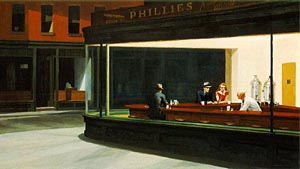 SAN
FRANCISCO -- For the last few months, the Whitney Museum in New York presented
a show grandly titled Edward Hopper and the American Imagination.
The museum catalogue, novelists and poets offer pieces that rhyme with Hopper's
titles. Movies, the film noire sort, like "Rear Window" and "Laura"
were shown. Art historians noted the way Hopper's use of commercial symbols anticipated
Andy Warhol's "Soup Cans." At the center of all the words remain the
enigmatic paintings of Edward Hopper, American.
SAN
FRANCISCO -- For the last few months, the Whitney Museum in New York presented
a show grandly titled Edward Hopper and the American Imagination.
The museum catalogue, novelists and poets offer pieces that rhyme with Hopper's
titles. Movies, the film noire sort, like "Rear Window" and "Laura"
were shown. Art historians noted the way Hopper's use of commercial symbols anticipated
Andy Warhol's "Soup Cans." At the center of all the words remain the
enigmatic paintings of Edward Hopper, American.
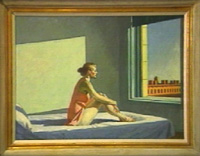 Edward
Hopper is not an American in the way we speak of Mark Twain or George Gerswhin,
as being characteristically American. There is something so odd, so incessantly
internalized about Hopper's vision that it defies place. Behind me here on the
sidewalk in San Francisco is the Green Street Market and Deli. In the America
of Edward Hopper, all specificity is wiped away.
Edward
Hopper is not an American in the way we speak of Mark Twain or George Gerswhin,
as being characteristically American. There is something so odd, so incessantly
internalized about Hopper's vision that it defies place. Behind me here on the
sidewalk in San Francisco is the Green Street Market and Deli. In the America
of Edward Hopper, all specificity is wiped away.
This facade, this grocery store, would become only
generic "Store Street." What matters to Hopper more powerfully than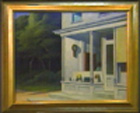 place
is time. So many of the titles of his paintings refer to time, not place "Morning
Sun," "Early Sunday Morning,7:00 A.M.". It is as though he senses
an America that is not a physical place. His America is a state of mind. He senses
the ruthlessness of Americans.
place
is time. So many of the titles of his paintings refer to time, not place "Morning
Sun," "Early Sunday Morning,7:00 A.M.". It is as though he senses
an America that is not a physical place. His America is a state of mind. He senses
the ruthlessness of Americans.
A generation after his death, he happily abandoned
any semblance of region or place for McDonald's and Wal-mart. Hopper, himself,
was born in Nyack, New York, in 1882. His family was solidly middle-class. As
a boy, he attended a Baptist church that his mother's grandfather had built.
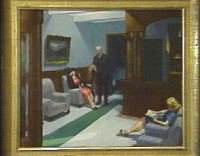 From
that early childhood, he intended to become a painter. Three times he traveled
to Paris as a young man. He sought the influence of the European masters, would
remain influenced by the Impressionists, but his great life journey would be across
America. When I look at Hopper's paintings, I think of Vladimir Nabakov's own
vision of America in his great novel Lolita, America as a series of train
compartments and hotel lobbies, America, the motel.
From
that early childhood, he intended to become a painter. Three times he traveled
to Paris as a young man. He sought the influence of the European masters, would
remain influenced by the Impressionists, but his great life journey would be across
America. When I look at Hopper's paintings, I think of Vladimir Nabakov's own
vision of America in his great novel Lolita, America as a series of train
compartments and hotel lobbies, America, the motel.
For nearly all of his adult life -- 50 years --
Hopper lived at the same address, a walkup on Washington Square in New York City.
He was married to one woman. Despite the conventionality of his domestic life,
he is famous for his paintings of hotel lobbies and diners. In Hopper, people
sit alone in places where one would 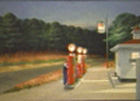 expect
crowds. Were we ever in love with this land? Were we ever at ease with the night
or the harsh glow of day? The American sky is fast. Huck Finn lies contentedly
on his back and considers the stars from his raft. But nature in Edward Hopper
is ominous. Who would dare drive the dark road beyond the Mobil Gas Station? And
nature seems unrelated to the narrative of our lives. The sun pours into the bedroom
but reveals nothing about the lives within.
expect
crowds. Were we ever in love with this land? Were we ever at ease with the night
or the harsh glow of day? The American sky is fast. Huck Finn lies contentedly
on his back and considers the stars from his raft. But nature in Edward Hopper
is ominous. Who would dare drive the dark road beyond the Mobil Gas Station? And
nature seems unrelated to the narrative of our lives. The sun pours into the bedroom
but reveals nothing about the lives within.
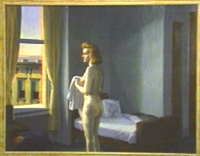 What
did Edward Hopper know of the condition of our lives? He died in 1964, just about
the time when Americans were beginning to abandon the neighborhood diner for McDonald's,
just when we were beginning to abandon Main Street for the suburban mall.
What
did Edward Hopper know of the condition of our lives? He died in 1964, just about
the time when Americans were beginning to abandon the neighborhood diner for McDonald's,
just when we were beginning to abandon Main Street for the suburban mall.
Had he lived a few years longer, how would he have
painted the new generic spaces where we now spend our lives wandering and waiting?
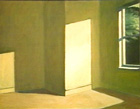 We have ended up
with everyplace to go. We end up alone. We end up people without a clear narrative.
Why is that lady waiting at the window? Her nudity reveals no answers.
We have ended up
with everyplace to go. We end up alone. We end up people without a clear narrative.
Why is that lady waiting at the window? Her nudity reveals no answers.
A year before he died, Edward Hopper was pestered
by an interviewer, asked what he was after with his painting called "Sun
in an Empty Room." Hopper replied, "I am after me!"
[Editor's Note: Edward Hopper is
generally considered the major twentieth-century realist. Such paintings as that
of Nighthawks seem to embody the very character of our time. Yet few people
have penetrated the mask of Hopper's public image. In Richard Rodriquez review,
Tower 2000 News has gone beyond the standard evaluations of the man and his work
to investigate the authentic identity of the artist and the way his personality
informed his art. Rodriquez addresses aspects of Hopper's fascinating and often
poignant life and Hopper's long struggle for recognition reveals a complex, introspective
and intellectual, yet romantic artist of our time, illuminating some of the many
levels of meaning in the paintings.]
Letter to the Editor
©1984-2000 TNT Newspaper. All rights reserved.





